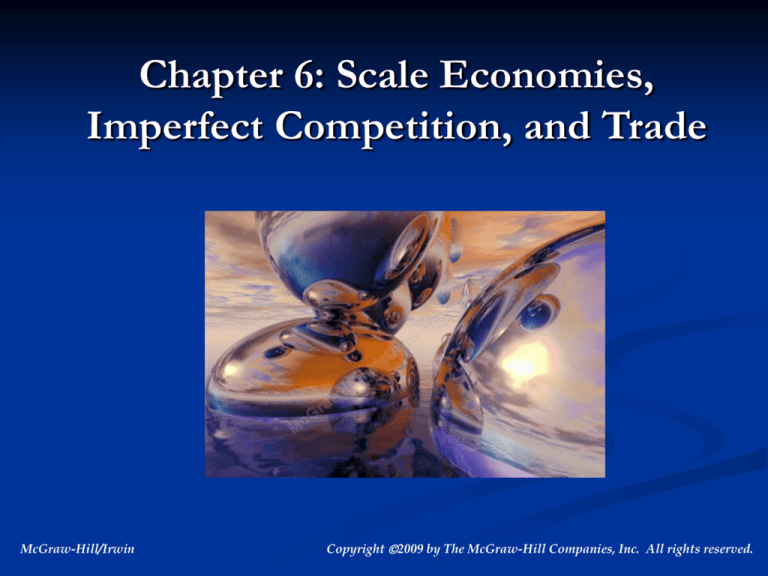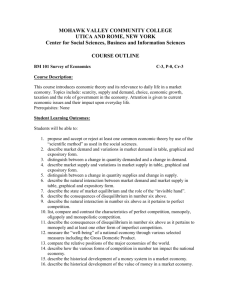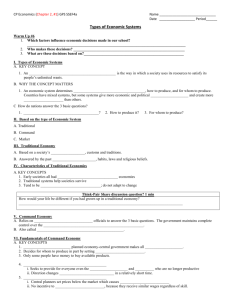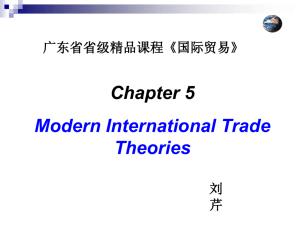
Chapter 6: Scale Economies,
Imperfect Competition, and Trade
McGraw-Hill/Irwin
Copyright 2009 by The McGraw-Hill Companies, Inc. All rights reserved.
6.1 Introduction
Chapter Objective:
To learn and understand the
major developments in trade
theories after the second World
War.
6-2
Contents
Intra-Industry Trade
Economies of Scale
Product Differentiation
Overlapping Demand
Product Cycle
6-3
6.2 Intra-Industry Trade
产业内贸易
Definition
Intra-Industry Trade
VS
Inter-Industry Trade
6-4
Measurement
Intra-Industry Trade Index
IITX = 1 -
ExportsX - ImportsX
ExportsX + ImportsX
0 < IITX< 1
6-5
IIT as a Percentage of Trade
in Nonfood Manufactured Goods
Country
1989
2005
United States
55.3
58.3
Canada
54.3
63.2
Japan
27.8
41.2
Germany
62.6
67.5
France
71.3
73.9
United Kingdom
69.0
71.7
6-6
6.3 Trade with
Economies of Scale
Internal Economies of Scale
External Economies of Scale
6-7
Internal vs. External
Economies of Scale
Firm’s
ACX
Firm’s
ACX
ACX
ACX
O
Firm’s Output
of X
(a) Internal
O
Industry Output
of X
(b) External
6-8
Internal Economies of Scale
Monopolistic Competition
垄断竞争
Modest Scale Economies
Oligopoly
寡头垄断
Substantial Scale Economies
6-9
Monopolistic Competition
and Trade
Firm’s Production
Decision without Trade
封闭条件下厂商的生产决策
6-10
Figure 6.4
Price and Cost per unit
(Millions of yen per car)
The Monopoly Element in
Monopolistic Competition
3.1
Demand (D0)
1.5
Average Cost
Marginal Cost
6
Quantity
MR0 (Millions of cars per year)
6-11
Figure 6.5
The Competition Element in
Monopolistic Competition
Demand (D0)
6-12
Firm’s Production
Decision Under Free Trade
开放贸易条件下厂商的生产决策
6-13
Figure 6.6
The Same Monopolistic
Competitor after Opening
Trade
6-14
Trade and Market Equilibrium
自由贸易条件下的市场均衡
6-15
Figure 6.7
The Automobile Market with No
Trade and with Free Trade
6-16
Basis for Trade
Product Differentiation
产品差异
Scale Economies
规模经济
6-17
Gains from Trade
More Varieties
Lower Prices
6-18
Welfare effects
Little impact on income
distribution between different
factor owners.
Gains from greater variety can
offset losses in factor income
resulting from inter-industry
shifts in production.
6-19
Oligopoly and International
Trade
Oligopoly 寡头
Duopoly 双寡头
Large Civil Aircraft Market
Boeing
Airbus
6-20
Oligopoly and Trade Pattern
Production is concentrated in
a few countries, which are net
exporters, and other countries
are importers.
6-21
What is behind this pattern ?
Comparative Advantage
Economies of Scale
6-22
Can this pattern be changed ?
Not easily.
Scale Economies
New entrants may suffer
losses for price reductions
and competition from old
firms.
6-23
Oligopoly and Gains from Trade
Oligopoly pricing
National support for highprofit oligopoly firms
6-24
External Economies of Scale
Industrial Agglomeration
产业集聚
Silicon Valley
Hollywood
Wall Street
6-25
(Short-run)
(Long-run)
46
6-26
Welfare effects
Producers in the exporting country
tend to gain producer surplus despite
of decline in price.
Producers in the importing country
lose producer surplus.
Consumers in both countries gain
consumer surplus.
6-27
Trade pattern
Similar to trade with substantial
internal economies of scale.
Determination of locations
• Size of domestic market
• Historical luck
• Government push
6-28
6.4 Technology-Based Theories of
Trade: The Product Cycle
Raymond Vernon 1966
雷蒙德·弗农 (1913-1999)
Harvard University
6-29
Product Cycle
New product
Mature product
Standardized product
Introduction
Maturity
Growth
Decline
6-30
Innovating
Country
Developed
Countries
Export
O
Import
t1
t2 t3
t4
t5
t
Developing
Countries
6-31
6.5 Overlapping Demands
as a Basis for Trade
Staffan B. Linder
1961
林德
6-32
Product
Quality
QAmax
QAmim
O
IAmim
IAmax
Income
6-33
Product
Quality
QBmax
QAmax
Trade
QBmim
QAmim
O
Income
Overlap
IAmim IBmim
IAmax IBmax Income
6-34
SUMMARY
Intra-Industry Trade
Economies of Scale
Product Cycle Hypothesis
Overlapping-Demand Hypothesis
6-35
6-36
6-37
6-38
6-39
6-40
6-41
6-42
6-43
6-44
6-45










